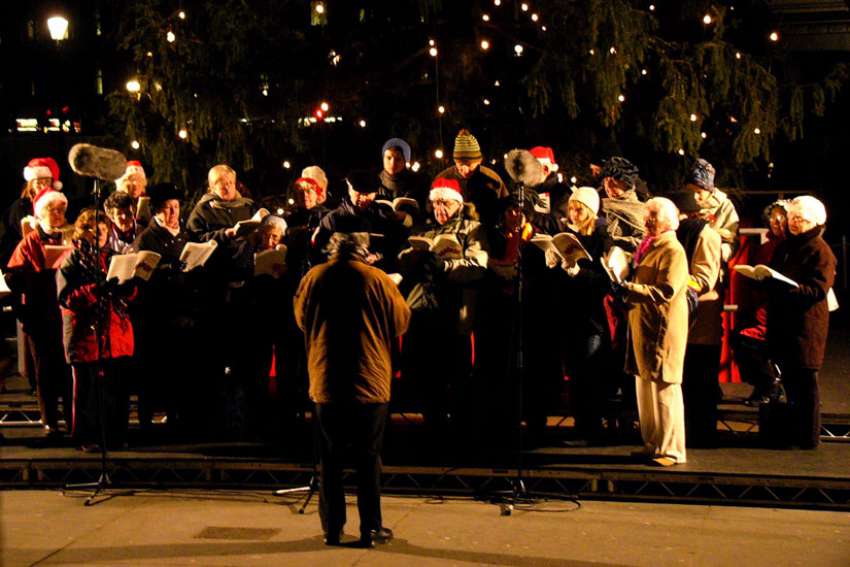Many people who haven’t really thought through what it might mean to reject the faith try to cobble together some sort of equivalent celebration that they hope will convey the same sort of meaning and reassurance as the traditional religious feast. What would’ve been called a Christmas Concert 50 years ago becomes “A Celebration of Light” or “Home for the Holidays” or, as I noticed on a community bulletin board just last week, “Songs for the Snowy Season.”
I’ve long found it fascinating — in a sad and tacky way — to root through the Christmas music section of used-record stores.
I don’t think anything so exquisitely summarizes everything I loathe about celebrity culture quite like these discarded collections of inane and once-trendy Christmas ditties by one-hit wonders, sit-com stars and non-musical hosts of daytime talk shows. These are some of the last people on the planet you’d want to salute from across a very large picnic field on Labour Day, let alone invite into your home and onto your sound system at the most special time of the year.
I used to think it was the mediocrity of talent that offended me in these seasonal turkeys until I saw The Three Tenors perform in some beastly Christmas gala about 10 years ago that was aired as a special fundraiser for the American PBS network. Placido Domingo, José Carreras, Luciano Pavarotti — presumably these gents could sing. But there they were in a concert hall the size of a small European country, reading from sheet music for a bombastically hollow rendition of “Jingle Bells” as if it were some aria from one of Verdi’s more challenging scores.
“Jingle Bells” is a ditty which, in all its contrapuntal complexity, 3-year-olds can memorize and will insist on singing non-stop unless you gently threaten to plaster their mouths shut with duct tape. And here were three of the most highly regarded voices on the planet grotesquely struggling to invest this slightest of musical trifles with so much meaning and decoration that it collapsed under all the effort.
The proceedings weren’t much more edifying when these celebrity blowhards tarted up more traditional, sacred carols with inappropriate vocal gymnastics.
So, no, it isn’t an absence of talent which offends me in so much modern Christmas music. It’s the presence of billowing egos, either in an ill-conceived song that seeks to imbue the secular with a quasi-sacred significance (as if snow or candles were in themselves holy artefacts) or in a grandstanding performance that screams, “Look what I can do with my voice here! Bet you can’t do this. Aren’t I fabulous?”
The best Christmas music is most beautifully realized when egos are left at the door. Even in a work of monumental genius like Handel’s oratorio, Messiah, there are no grandstanding moments when any of the soloists are allowed to pull away the listener’s concentration on the sacred story being told.
Most of the beloved Christmas carols are as simple as folk songs and sound best when they’re sung by choirs or unflashy solo voices in perfectly straightforward arrangements. One of the most sublime carols of them all, “O Come, O Come, Immanuel,” is one of the simplest. If you’ve ever seen the musical notation, there’s nothing but unadorned black dots on the page as the carol is derived from early-church plain chant.
I love getting out to a whole raft of professional choral concerts each Christmas. But the best version of Silent Night I hear all year is the one I help to offer up as one small part of our decidedly unprofessional congregation at London’s St. Peter’s Basilica at midnight Mass on Christmas Eve. The place is always packed to the proverbial gunwales and “Silent Night” is our final song before the Mass proper gets underway.
For some reason, the tempo for this carol always starts out geologically slow and just gets slower as we proceed. About one verse in, I start to lose myself in this gorgeous, oceanic sensation that I am nothing more than a piece of cork being sloshed from side to side of the cathedral on waves of sweetest sound.
After that experience, I’m ready to kneel before the crèche in utterly self-forgetting adoration.
(Goodden is a writer in London, Ont. His latest book is Three Artists: Kurelek, Chambers and Curnoe.)


